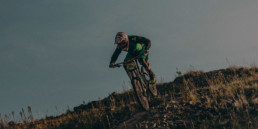Building bulldozer-proof trails
In the early days of freeriding, “dig first, ask questions later” was the mantra by which many unauthorized trailbuilders lived. Truth be told, some great freeride areas emerged from this method – but countless others have been razed by concerned landowners, and future trail access has been jeopardized.
To avoid watching your perfectly sculpted dirt jumps crushed by a 50,000-pound Caterpillar, it’s vital to obtain permission before building. Many, perhaps most, freeriders assume that approaching a land manager will only result in frustration. However, a growing number of trailbuilders are finding it’s possible to gain authorization and build the kinds of trails that put smiles on freeriders’ faces.
“Most riders have the potential to be good trailbuilders and partners in the fight for access, but too few of them build legally, or help with legal trailbuilding projects,” says Judd de Vall, a former pro rider, now a freeride bike advocate. “Here in Victoria, we’ve had four great jump spots plowed this year,” says de Vall. So, how does a freeride trailbuilder get permission to create a bike park, or technically demanding trails?
According to Rick Sokoloff, president of the Stowe (VT) Mountain Bike Club, the key is to build local partnerships. “At first, the freeride community was trying to do things on their own. Once they became involved with the club, there was a lot more weight behind their ideas,” says Sokoloff. By forging partnerships with local officials – including the Stowe Recreation Department, the town’s Conservation Commission, the Select Board and local landowners – the Stowe Mountain Bike Club was able to obtain permission to build the Mayo Farm bike park.
The park was an instant hit with riders, as well as the larger community. “We’ve seen an awful lot of positive energy from all sorts of people in town, from young riders to older guys like me, and also from local business owners who think it’s a great addition for a ski town,” says Sokoloff.
Shortly after the park was built, a small number of local landowners with abutting properties asked town officials to remove or modify the bike park, claiming it was an eyesore and a legal liability. Sokoloff says the club’s adherence to a pre-approved plan, and the attention to detail they used in construction, saved the park. “Our proposal was very detailed, and we followed it to the letter during construction. We were able to show that everything was in order, and that we were following through on what we promised.”
De Vall agrees that an established bike club is a freerider’s best resource. “I serve on the South Island Mountain Bike Society (SIMBS) Board of Directors, where I help with freeriding issues,” says de Vall. Although the club still faces many challenges with getting freeriders involved, SIMBS has earned some solid results, and recruited new members.
The crucial step, says de Vall, is to bring locally prominent freeride trailbuilders into the fold. “We reach out to the top riders, who are also usually the leading builders, and ask them to work with us on things that will help gain authorization for their projects. We advise adding roll-able lines and progressive difficulty for jumps – features that will convince land managers that these trails enhance local recreation opportunities.”
“I want to help boost the legal freeride scene in our area,” says de Vall. “I’d like to get more kids into jumping and racing downhill, and to have cool spots where kids can ride without seeing their trails plowed every few months.”



